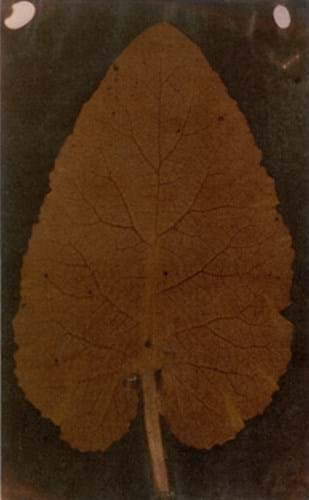
The auctioneers chose to postpone the sale of a photogenic drawing of a leaf that at least one expert believes dates from the 1790s. The move came just days ahead of the April 7 sale after contact from other experts.
In a statement, director of Sotheby's Photographs department Denise Bethel said: "Following the publication of the catalogue scholars across the field of photography have entered into a spirited and lively dialogue about the possible origins of the leaf. Dr Larry Schaaf's essay, which comprised our copy for the lot, has inspired and attracted much discourse."
Dr Schaaf, a recognised authority on the work of William Henry Fox Talbot, argues that this image (traditionally attributed to the father of photography) lies outside the corpus of his known work and that of his followers and appears to be earlier. He notes it is one of a group of six anonymous photogenic drawings from an album belonging to one Henry Bright sold by Sotheby's in London in 1984.
Bright was a Victorian photography enthusiast from a prominent Bristol family whose father, Richard Bright, was a gentleman scientist who is known to have come into contact with the pioneers of photographic experiment. Among these was Thomas Wedgwood (1771-1805) of the famous Staffordshire family who, sometime in the 1790s, is known to have began experiments on what he called 'solar pictures'.
Writing in the sale catalogue, Dr Schaaf asserts: "He gave up on cameras and instead concentrated on photograms, placing leaves and other objects on silver nitrate coated paper and white leather to form negative images, much the same as Talbot was to do several decades later."
References to Wedgwood's work survive in an account published by his friend Humphry Davy in 1802 and in the writings of Samuel Highly, who, when campaigning for the establishment of a photographic library and museum in 1885, spoke of "looking at specimens of some of Wedgwood's experiments with chloride of silver on bibulous paper".
Dr Schaaf's speculation is partly based on the letter W to be seen inscribed in the bottom-right corner of the image and four others in the Bright album that was broken up at Sotheby's in 1984.
This particular image was acquired by New York dealer Hans P. Kraus Jr., passing in 1989 to Jill Quasha, a private dealer who assembled a major 19th and 20th century photography collection on behalf of Quillan Company, a private investment group. Two other images (one botanical, the other of keys) are in private collections, the Getty have two botanical studies while the Met have an image of a shark egg case. All share the distinctive deep reddish colour, typical of primitive photographic 'drawings' that have not been fixed and must be kept in the dark (the main reason why so little early material is thought to have survived). Sotheby's, who published no estimate for the image, used a facsimile to show it as part of the Quillan collection.
Dr Schaaf's hypothesis that the work could predate Talbot would, if confirmed, make this one of the most important discoveries pertaining to the history of photography. They also appear to have struck a chord with other photo historians who exchanged views online. The withdrawal of the lot from sale does not, in this case, mean that Schaaf was wrong in his assertions.
Denise Bethel added: "This conversation [between scholars] has revealed new areas of research, which will be explored in the coming months." She said that she hopes to bring the image up at a later auction, perhaps with an entire catalogue devoted to its history.




